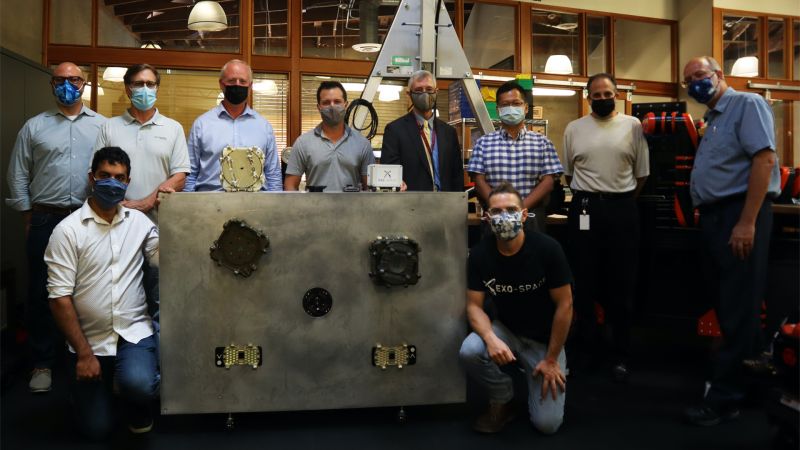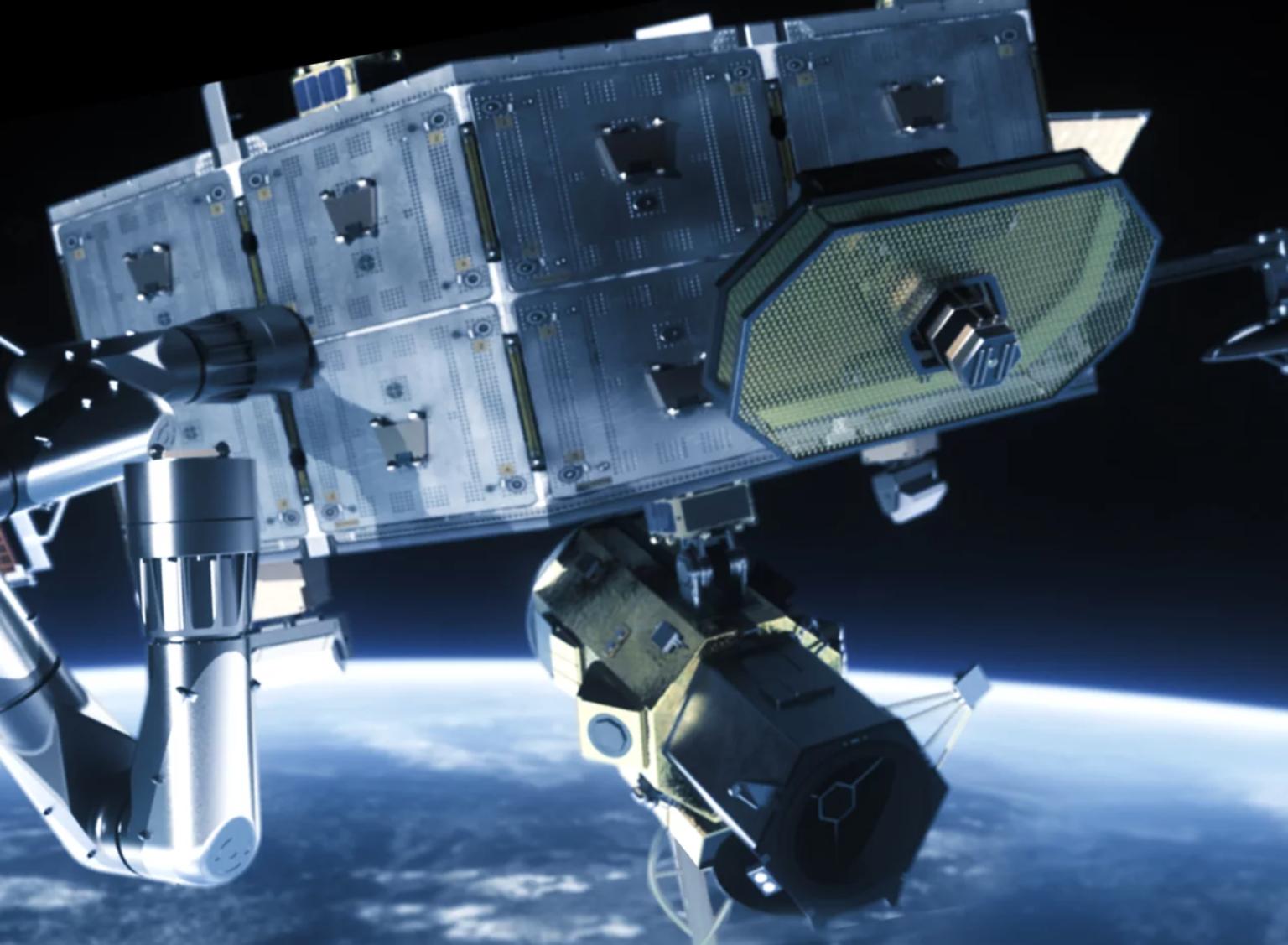Space Force Awards $1.6M Contract to Space Port Manufacturer – Interview
Arkisys, alongside partners Qediq, Novawurks, Motive Space Systems, iBoss, and the Texas A&M Engineering Experiment Station (TEES), has received a Direct-to-Phase II Small Business Innovation Research (SBIR) $1.6 million grant from the SpaceWERX – the innovation arm of the U.S. Space Force (USSF). The funds will go towards demonstrating the building of a standalone three-axis stabilized satellite on Earth using Arkisys’ innovative Port Module spacecraft, which will one day function as a pioneering space outpost and orbital destination to host new technology and build new satellites onboard, among other things.
According to the Los Alamitos, California-based company, additive manufacturing (AM) is a big part of its space innovation strategy, so Arkisys and its partners will rely on the technology for its prototype satellite model.
“This new effort expands the overall services we have created to include the high fidelity manipulation required to assemble and then release a new space platform off of our Ports in orbit,” said Arkisys CEO and Co-founder David Barnhart. “This award opens up a unique methodology to support on-orbit flexibility, mission change in flight, high fidelity manipulation, and assembly of complex objects. And it’s super cool!”
Through this SBIR grant, Arkisys and its partners will address using resources in space to create new platforms or modify them on the fly rather than only build new ones, explains Novawurks CTO Talbot Jaeger. In particular, the novel small satellite technology developer will supply a system called HISat to achieve a full-scale demonstration of how the Port Module can create a space system from parts into an operational element.
The team will execute a full-scale demonstration in 1G to assemble a separable functional space platform to validate the robotic operations on Earth’s version of the Port Module.
“The ability to assemble a functional satellite off of another platform is something that will open up not just Earth orbit markets and on-the-fly changes to existing satellites, but to on-demand satellites for lunar or Martian exploration,” stated Dr. Robert Ambrose, director of space and robotics initiatives at TEES. “This is incredibly exciting for us as we are developing platforms to validate and demonstrate higher fidelity robotics on orbit, to build, assemble, repair and operate.”
https://vimeo.com/arkisys/the-port
Space economy at its best
Since its founding six years ago, Arkisys has been stealthily building one of the first business platforms in space. This so-called Port Module is a lighthouse in orbit and a beacon to enable existing and new customers and markets in Earth orbit, the Moon, Mars, and beyond. The Arkisys Port Module supports scaleable rapid prototyping, new payload, technology testing, assembly, and integration of new free-flying space platform destinations for orbital transfer vehicles and on-orbit assembly and manufacturing.
 Arkisys unveils its first generation orbital outpost spacecraft element, the Port Module Wedge, planned for its first use on its initial Space Outpost in low earth orbit, as well as subsequent future missions and destinations. Image courtesy of Arkisys.
Arkisys unveils its first generation orbital outpost spacecraft element, the Port Module Wedge, planned for its first use on its initial Space Outpost in low earth orbit, as well as subsequent future missions and destinations. Image courtesy of Arkisys.Earlier this year, 3DPrint.com talked to Arkisys Chief Business Officer (CBO) Dan Lopez about the company’s spaceport and how it will provide a stable, long-duration platform for 3D printing and manufacturing in microgravity. Lopez even confirmed that the company relies on 3D printing to build the Port Module spacecraft, specifically for sub-components or modules within the spacecraft.
“We have the full gamut of 3D printing, on Earth and in space,” says Lopez. “Aside from developing parts in our California headquarters, we will have a sort of ‘maker space’ in orbit. Mainly thanks to our platform, which will create a destination to test 3D printing hardware and 3D biologics in space without worrying that astronauts will have to test the research.”
 Arkisys unveils updates to its space Port Module architecture. Image courtesy of Arkisys.
Arkisys unveils updates to its space Port Module architecture. Image courtesy of Arkisys.Beyond the ISS
In the past 21 years, the International Space Station (ISS) ‘s unique laboratory in LEO has offered astronauts the ideal microgravity conditions to test more than 3,000 experiments, hardware, and research. Yet, as incredible as many of these innovations have been, they still demand a human component, so many experiments are left behind to avoid putting the livelihood of astronauts living onboard at risk.
For example, Lopez suggests that startups interested in testing specific biologics in space, such as viruses, cannot use the ISS; instead, a robotized spacecraft like Arkisys’ Port Module would fare well without placing any lives at risk. This is because Arkisys’ new platform is being “trained” to create a new ecosystem where robotic arms manipulate and move everything, from 3D printing feedstock to the actual output, which will ultimately be placed into storage bins or return vessels for a return trip to Earth, or eventually being shipped somewhere else, like the Moon or Mars.
Key to its success will be unlocking undiscovered markets and enabling pioneering technologies for the new ecosystem of space development. According to our research, that usually translates into 3D printing innovations. Lopez confirms that the platform will be home to plenty of startups with an SBIR or STTR federal grant but need additional help to get their projects to space. That’s where Arkisys comes in.
With Arkisys’ proposal, more companies than ever will get the chance to apply for a “free ride” to the Port Module as long as they can pay for some of the spacecraft integration costs. As Arkisys recently announced the launch of its “Embark” program, a global initiative designed to open new doors for innovators by accelerating and simplifying access to orbit for their early-stage technologies and business ideas. For this first phase, only U.S. companies currently in the process of or were recently funded as part of any SBIR/STTR Phase I or II effort are eligible. These companies are being offered a unique opportunity to utilize Arkisys’ on-orbit Space Port as an addition or alternative to the government-funded effort.
Lopez explained that the brand understands how difficult it is to land a Phase II or III contract with government agencies. While Phase I generally awards grants between $50,000 and $250,000 to establish the technical merit, feasibility, and commercial potential of the proposed R&D efforts, Phase II and III awards help continue the work and can help place a project in orbit but are often much more challenging to land, leaving some worthy efforts without a defined path forward. Arkisys via Embark can allow these companies to continue their work and launch their innovations into orbit. In addition, once on board, additional opportunities are available to scale the experiments and collaborate with others on the Port Module.
 Arkisys space Port Module rendering. Image courtesy of Arkisys.
Arkisys space Port Module rendering. Image courtesy of Arkisys.Barnhart has been a program manager for the Defense Advanced Research Projects Agency (DARPA) for over three years, so he understands the essentials behind government funding programs. Together with Lopez, he has been searching for a way to build infrastructure and superhighways in space. Today, with the company landing a new Space Force grant, launching the Port Module to space feels closer than ever.
Subscribe to Our Email Newsletter
Stay up-to-date on all the latest news from the 3D printing industry and receive information and offers from third party vendors.
Print Services
Upload your 3D Models and get them printed quickly and efficiently.
You May Also Like
3D Printing Financials: Xometry Cuts Losses, Grows Platform
Xometry (Nasdaq: XMTR) is entering 2025 with momentum. The company delivered record quarterly revenue and narrowed its losses, showing progress toward profitability. More importantly, for those watching the future of...
3D Printing News Briefs, May 7, 2025: Sales Partner, Seawalls, Ceramics, & More
We’ll take care of some business first in today’s 3D Printing News Briefs, as Meltio announced an official sales partner in Portugal, and Kind Designs received about $1 million in...
3D Printing Financials: Protolabs Reports 3D Printing Dip, But Metal 3D Orders Grow
Protolabs (NYSE: PRLB) kicked off 2025 with a mixed but steady performance. Revenue remained close to expectations, profits dipped slightly from last year, and the company was profitable despite ongoing...
Johns Hopkins University Researchers Develop HyFAM Technology
Two scientists from Johns Hopkins University, Nathan C. Brown and Jochen Mueller, have developed a hybrid manufacturing technology they call HyFam, or Hybrid Formative Additive Manufacturing. Their work on this technology...





























